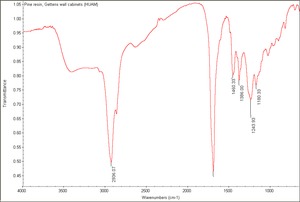Balsam
Description
An oleoresinous exudate from Coniferae trees, especially of the Pinus family. Balsams have been used since antiquity for medicinal purposes and as sealers. The exudate is a soft, semi-liquid consisting of terpenes of resinous character and a large amount of essential oils. Upon distillation, a liquid portion, called turpentine, and a solid residue, called Rosin, are produced. Balsams have been used in varnishes and paint mediums; however, they deteriorate easily unless a harder resin is mixed with them. The U.S., France and Spain are the largest producers of balsams. Examples of balsam resins include Venice turpentine, Strasbourg turpentine, Canada balsam, and Copaiba balsam.
Synonyms and Related Terms
turpentine; colophony; rosin; Greek pitch; Venice turpentine; gum thus; Canada balsam; Copaiba balsam; pine resin; gemme; larch balsam; Strasbourg turpentine; tolu balsam; burgundy pitch; oleoresin; baume (Fr.)
Physical and Chemical Properties
Insoluble in water
Resources and Citations
- R. J. Gettens, G.L. Stout, Painting Materials, A Short Encyclopaedia, Dover Publications, New York, 1966
- G.S.Brady, Materials Handbook, McGraw-Hill Book Co., New York, 1971 Comment: p. 298
- Reed Kay, The Painter's Guide To Studio Methods and Materials, Prentice-Hall, Inc., Englewood Cliffs, NJ, 1983
- Ralph Mayer, A Dictionary of Art Terms and Techniques, Harper and Row Publishers, New York, 1969 (also 1945 printing)
- Richard S. Lewis, Hawley's Condensed Chemical Dictionary, Van Nostrand Reinhold, New York, 10th ed., 1993
- The Merck Index, Martha Windholz (ed.), Merck Research Labs, Rahway NJ, 10th edition, 1983 Comment: entries 973-977
- Art and Architecture Thesaurus Online, http://www.getty.edu/research/tools/vocabulary/aat/, J. Paul Getty Trust, Los Angeles, 2000
